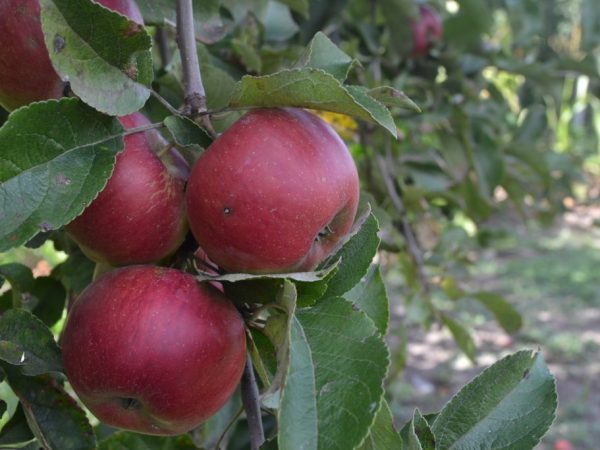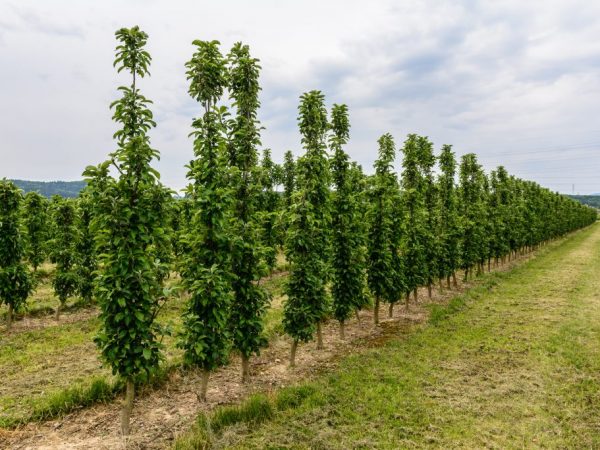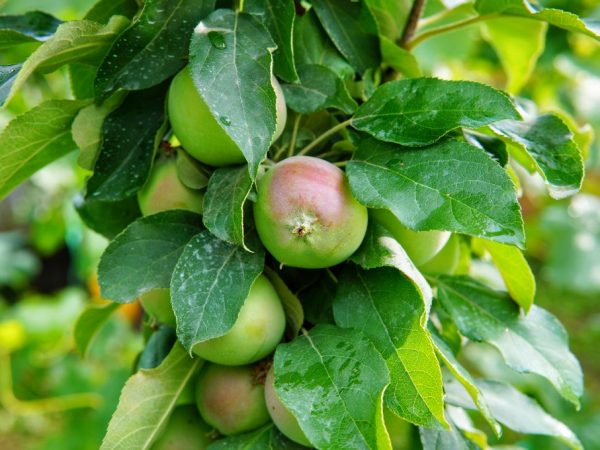Yesenia columnar apple variety
An artificially bred apple tree of the Yesenia variety is valued for its early maturity - with good care, the tree begins to bear fruit in the second year after planting. The plant gives good yields, which increase every year. For these qualities, the tree has gained great popularity among gardeners in our country.

Yesenia columnar apple variety
Description of the variety
The late-ripening culture has several unique characteristics:
- a tree of compact size - reaches 2.5-3 m in height, does not form lateral branches, therefore it does not require much space on the site;
- crown width is 40-60 cm;
- leaves are dark green, large, glossy, without pubescence;
- apples of crimson or burgundy color, thick-skinned, weighing from 160 to 180 g;
- the taste of the fruit is very sweet, with a slight sourness, the pulp is juicy and firm, creamy or white.
Growing regions
This culture is successfully cultivated in many regions of our country - in the Volga region, Chernozem region, Moscow, Smolensk, Kaluga and Ryazan regions.
The highest yield indicators are noted in the south.
Advantages and disadvantages
Several important qualities are distinguished from the advantages of the variety:
- early fruiting, which occurs in the second year of cultivation;
- the plant annually increases the amount of harvest - about 10 kg of fruits can be removed from one adult tree;
- compact size, therefore suitable for growing in small areas;
- good taste and marketability - tasting grade 4.7 points on a five-point scale;
- resistance to various fungal infections is high - it is practically not damaged by scab, powdery mildew and fruit rot.
The disadvantages include weak winter hardiness - a tree can winter without shelter only in the southern zone, in other regions it must be covered.
The bark on the trunk is very thin, so the trunk is often damaged by pests and unfavorable weather conditions (winds, rains). To do this, create effective protection against injury. In regions with strong winds, a garter and support are needed to protect the tree from breaking off and uprooting.
Another disadvantage of the variety is the short fruiting period from 10 to 12 years.
Planting and care rules
According to the description, Yesenia's columnar apple tree has a weak root system, so it is often damaged by winds. To avoid this, it is necessary to plant seedlings in an elevated and calm place. The tree needs good lighting with a little shading.
Timing
Given the weak resistance to frost, the tree should be planted in the spring, so that over the summer it gets stronger, adapts and prepares for future wintering.
The optimal time for planting is mid to late April.
Saplings
Gardeners who are engaged in the cultivation of this crop recommend taking annual seedlings for planting - they have good survival rate and the ability to grow quickly in a new place.
Before planting, the roots on the plant are trimmed to a length of 3-4 cm, then the roots are dipped in a clay chatterbox for an hour. A solution is prepared from 3 liters of water and 3 kg of clay.
The soil

The yield of apple trees depends on the fertility of the soil.
If you want to get a bountiful and tasty harvest, you should take care of the fertility of the soil in advance. The site is freed from the remnants of last year's vegetation, sprinkled with humus at the rate of 10 kg / m². Then carry out digging and leveling. Site preparation is carried out in the fall.
With the arrival of spring, when the heat outside stabilizes and the snow melts, they begin to prepare holes. The optimal size of the landing holes is 60x80 cm.
Crushed stone or pieces of broken brick are laid at the bottom. In the future, they will serve as good drainage and prevent rotting of the root system from excess moisture.
The pit is half filled with a nutrient composition from dug garden soil, 100 superphosphate, 100 g of potassium sulfate, 5 kg of humus (compost) and 3 kg of wood ash. Sprinkle this mixture on top with soil without fertilizers.
Landing technique
Before disembarking, a peg is driven into the pit for support. The seedling is placed on an earthen hill, the roots are straightened, sprinkled with earth and trampled in the area of the trunk circle.
At a distance of 40-50 cm from the trunk, 3 holes are pulled out for irrigation. When planting, a young plant needs 10 liters of water. After planting, the soil around the tree is mulched with a thick layer of earth to avoid moisture evaporation. After planting, the tree is tied to a support with a rope or twine.
The main rule of successful cultivation is that the tree must be planted in the ground so that the root collar is just above the surface of the soil, otherwise the risk of rotting of the young trunk is inevitable.
Care rules
With good care, the columnar apple tree of Yesenia does not get sick, it grows intensively and every year it gives an increasing yield of delicious fruits.
Watering
For active growth of green mass and root system in the first years of life, seedlings require frequent and abundant watering. In a dry summer, it is carried out every two weeks - 2 buckets of water are poured under the root.
For grown trees that have begun to bear fruit, watering is reduced to five times per season. Consumption per copy - 4-5 buckets.
- The first moistening is carried out in early spring to stimulate the growth of young growth and roots.
- The second time the soil is moistened 1-2 weeks before flowering, then 2 weeks after it. At the stage of pouring the fruits, the tree is especially demanding on moisture - 7 buckets of water are poured under each apple tree. Trees saturated with moisture give juicy and large fruits.
- The last moistening is carried out in the fall after leaf fall - 10 buckets per plant. Moisture-charging irrigation provides plants with good resistance to wintering.
Top dressing
In the early years, the seedlings do not require any nutrition, since the fertilizers laid during planting are enough for 2 years.
In the third year, food is carried out according to the following scheme:
- at the beginning of spring, the near-stem zone is watered with a solution of nitrophoska or ammophoska - 1 tbsp. l. on a bucket of water;
- before flowering, add superphosphate and potassium salt - 1 tbsp each. l. for 10 liters of water;
- the same composition is used at the stage of pouring the fruit;
- in late autumn, when the tree sheds its foliage, a complex composition of superphosphate (15 g), potassium nitrate (10 g) and azophoska (5 g) is added.
Each fertilizer is combined with watering to improve the absorption of nutrients and prevent the risk of root burns.
Loosening

It is important to properly care for the root system.
The plant has a weak root system, which is not able to fully receive oxygen.
To increase moisture and air permeability, the soil is loosened after each watering.
Additionally, in the near-stem zone, you can sow plants that not only scare off parasites, but also increase soil aeration - marigolds, calendula, lemon balm, dill and parsley.
Pruning and shaping
This tree does not need crown formation, since genetically it does not form lateral branches.
The first and last haircut is carried out immediately after planting the tree - the central conductor is shortened by a third of the length.
In the process of growth, it is necessary to examine the tree for damage to the trunk by parasites and diseases. All the affected areas are cut out, treated with a solution of copper sulfate, then with garden varnish.
Disease prevention
The columnar apple tree has good immunity against diseases, infection occurs extremely rarely and only if the basic rules of agricultural technology are not followed.
In case of damage by powdery mildew or scab, the trees are irrigated with a solution of copper, iron sulfate or Bordeaux mixture.
Processing must be carried out one month before the planned harvest. The same drugs are used for preventive treatments in early spring and late autumn.
Insecticides - Actellik, Karate, Fundazol or Aktara help to cope with the codling moth, leafworm, spider mite and whitefly.
Preparation for wintering
This is one of the most important stages - the future health of the tree and its further fruiting will depend on high-quality insulation.
A month before the planned frost, the trunks are whitewashed, then mulching the near-trunk zone with garden soil. The trunk is wrapped in foil, and after the snow falls, it is covered with a snowdrift. Young plants of short stature can be covered with a cardboard box, burlap, spunbond, which will create additional protection for the entire trunk.
Ripening and fruiting
According to the description, this crop belongs to the late varieties of the autumn ripening period - the harvest ripens in September or October. The fruits do not fall off the tree for a long time, and after harvesting they are well stored in a cool place - until spring.
The harvested crop is placed in wooden boxes or cardboard boxes, shifting each layer with thick paper (hay, straw), then transferred to the basement or cellar.
Optimal storage conditions are temperature within 3-5 ° С and humidity at 55-60%. The room should be well ventilated and there should be no dampness or mold, otherwise the apples will quickly deteriorate.
The opinion of gardeners about the variety
Esenia's apple tree received many positive reviews from gardeners - the yield is consistently high, the keeping quality of the fruits is good.
Many successfully grow this crop in risky farming zones, providing good protection for the winter. As practice shows, trees are not damaged by diseases, and the yield remains at the highest level.
Some gardeners note that the tree is very fragile and cannot withstand strong winds, so it is important to provide good support and find a quiet place for planting.

